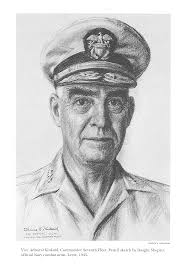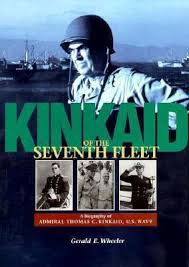
Admiral Thomas Cassin Kinkaid played a critical yet often underappreciated role in the Pacific Theatre during the Second World War. As commander of the United States Navy’s Seventh Fleet, Kinkaid found himself in a highly unusual position: a senior naval officer operating under the authority of an army general—General Douglas MacArthur—in the Southwest Pacific Area (SWPA). This arrangement, driven by political compromise and strategic necessity, created a complex and at times strained working relationship between the two men and highlighted the broader tension between MacArthur and the United States Navy.
An unusual command structure
Kinkaid, a 1908 graduate of the US Naval Academy, had served with distinction in both world wars. He was known for his calm demeanour, professionalism, and diplomatic skill. These qualities would prove essential as he took command of the Seventh Fleet in 1943. From the outset, his role was shaped by an unusual command structure. While the fleet was part of the US Navy, it operated under the strategic direction of MacArthur, who was supreme commander of Allied forces in the SWPA. This arrangement placed Kinkaid in the difficult position of answering to both the Navy’s leadership in Washington and an army general with a notoriously strong personality and a deep sense of independence.
MacArthur and the US Navy: competing priorities
The operational tensions between MacArthur and the Navy were longstanding. MacArthur often believed that the SWPA was receiving fewer resources than it deserved, particularly in comparison to the Central Pacific campaign under Admiral Chester Nimitz. He lobbied continuously for more ships to support his aggressive island-hopping strategy, which aimed to liberate New Guinea, the Philippines, and eventually reach Japan via the western Pacific. However, the Navy, especially under Admiral Ernest King, Chief of Naval Operations, had different priorities and regarded MacArthur’s demands with suspicion. King, in particular, had a personal dislike for MacArthur and prioritised the Central Pacific route as the primary path to victory.
Kinkaid’s balancing act
Caught in the middle of this strategic tug-of-war was Kinkaid. While he was loyal to the Navy, he was also a dedicated commander who understood the importance of supporting ground operations in the SWPA. He managed to work with MacArthur more effectively than many expected, often subordinating his own instincts and professional preferences to maintain cohesion within the Allied command. Nonetheless, the strain of balancing these competing loyalties was never far from the surface.
Leyte Gulf and command breakdown
One of the most notable incidents reflecting this tension was the Battle of Leyte Gulf in October 1944. This massive naval engagement was pivotal in the campaign to liberate the Philippines. Kinkaid’s Seventh Fleet was tasked with covering the amphibious landings at Leyte, while Admiral William Halsey’s Third Fleet operated independently under Nimitz’s command. When Halsey moved his forces north to engage a Japanese decoy force, he left the San Bernardino Strait unguarded. This nearly allowed a Japanese fleet to attack the vulnerable landing forces. Kinkaid had assumed Halsey would guard the strait, but Halsey had other plans. The ensuing confusion laid bare the dangers of a fractured command system. While MacArthur blamed Halsey for the oversight, the incident highlighted the broader problems of overlapping jurisdictions and poor coordination between the Central and Southwest Pacific commands.
A quiet professional in turbulent waters

Despite these challenges, Kinkaid maintained a professional working relationship with MacArthur throughout the war. This was no small feat, given the general’s well-known impatience with subordinates and his frequent clashes with naval authorities. Kinkaid managed to avoid the public quarrels that defined some of MacArthur’s other military relationships, though private frustrations certainly existed. Gerald E. Wheeler’s biography, Kinkaid of the Seventh Fleet, touches on these tensions, noting Kinkaid’s ability to maintain discipline and focus even in the face of operational and political pressure.
